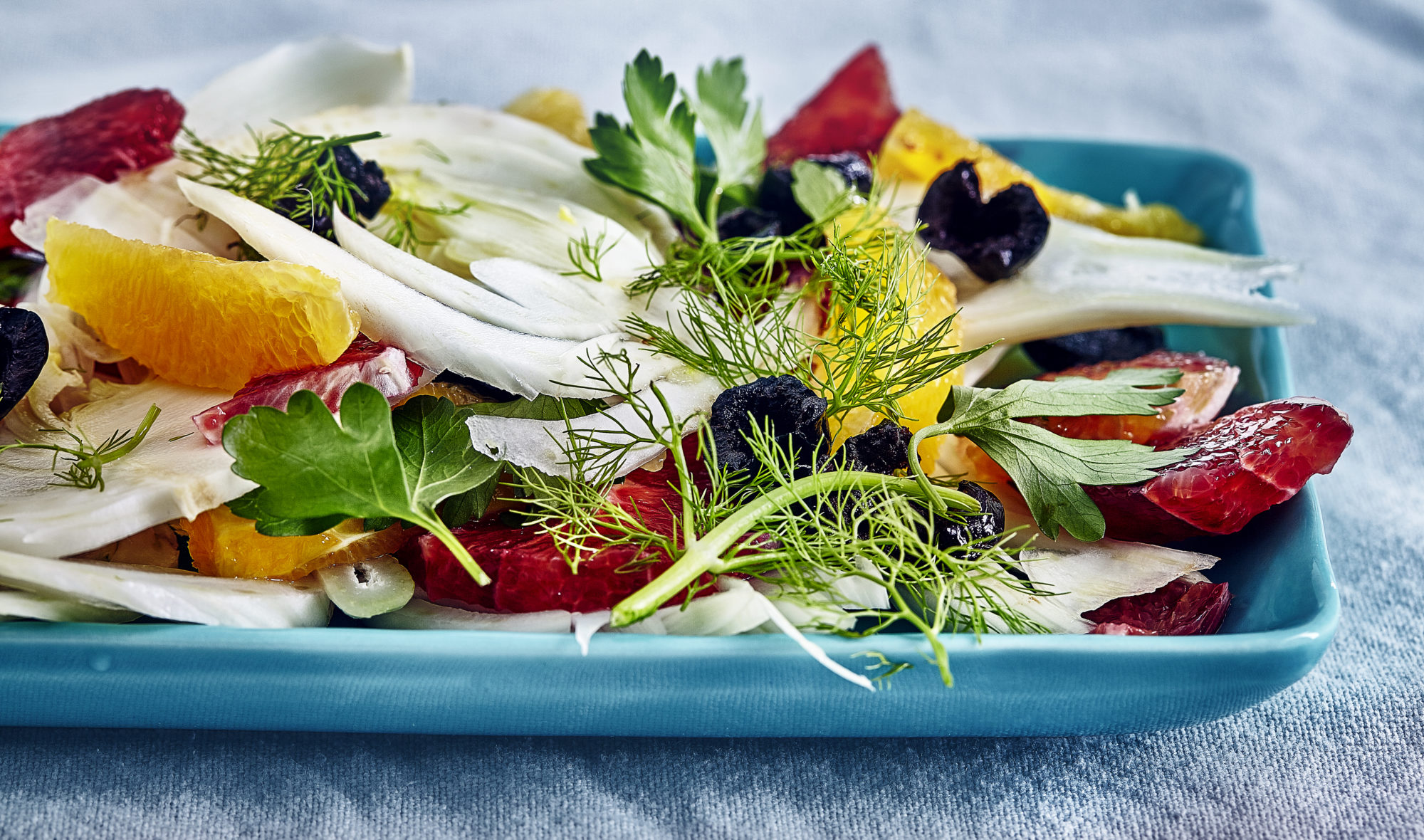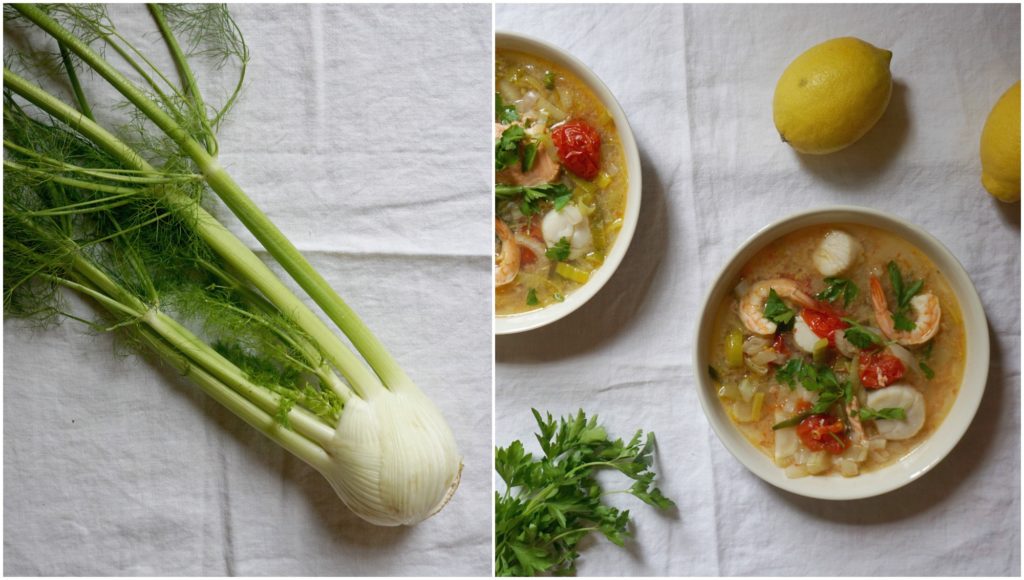
Join PN Level 2 for less than $9 USD/day! Affordable monthly payments now open.

Fennel is a vegetable that is either loved or hated. The lovers out there will appreciate its crunchy, celery-like texture and its unique licorice-y, anise-y flavor. The haters may appreciate fennel more in its cooked form. Sautéed, roasted, or braised fennel mellows in flavor and softens in texture, making it more universally appealing. Although fennel is not commonly used in standard American cuisine, it is popular in Europe, particularly in Italy. Fennel bulb is an integral part of many stews and tomato sauces, and its seeds are used to flavor sausages. Like many vegetables, fennel is high in fiber and low in calories. Experiment with trying fennel raw and finely sliced, tossed with some other fresh vegetables and a simple dressing.
Fennel is a vegetable that is tough to put in a box. It is somewhat like celery, in that it has a layered configuration of pale green fibrous stalks. It is somewhat like dill, in that it is topped with feathery green leaves. With its unique sweet, licorice-y, anise-y flavor, you might look at this plant and go, “Huh?”
Despite its infrequency in standard American cuisine, fennel is well known in European cuisines, particularly Italian. Both the vegetable and the seeds it bears are commonly used in stews, sauces, broths, and sausages. Fennel pairs well with tomato, fish, and pork, and adds a mellow sweetness to a dish.
Like cilantro, fennel tends to be a food that’s either loved or hated. For the haters out there, please note that fennel’s flavor is much more assertive when raw. Therefore, try roasting or sautéing it, and then reassess your hate.
To describe a fennel bulb, start with the mental image of a bunch of celery. Make the base a bit more pale and bulbous, and the ends a bit darker and more tapered. Finish the stalks with feathery, dill-like leaves.
The entire plant is edible, and all parts have a flavor that is a cross between celery, anise, and licorice. The pale parts of the plant (near the bulb) tend to be milder flavored and the top parts (the darker green stalks and leaves) tend to be stronger flavored.
Generally, it is the base of the plant that is preferred for culinary preparations because of its delicate flavor and less coarse texture. In texture, fennel is very similar to celery, complete with its satisfying watery crunch and stringy fibers.
When cooked, the flavor of fennel softens greatly, as does its texture, making it less polarizing for discriminating palates.
One cup of sliced, raw fennel (about 87g) has 27 calories, 1.1g protein, 0.2g of fat, 6.4g of carbohydrates, 2.7g fiber, and 3.4g sugar. Raw fennel is a good source of vitamin C.
Fennel is available at most larger grocery stores and fruit and vegetable markets.
When selecting fennel, look for bulbs that are smallish, as these will usually be younger and more tender. Find bulbs that are heavy for their size, with straight, firm stalks that don’t splay out too much. The stalks and the leaves should look fresh and green, without signs of wilting, splitting, bruising, or yellowing. Good fennel should smell fragrant and sweet.
Store fennel in the crisper drawer of the fridge for three to four days.
Fennel can also be blanched and then frozen for up to six months, although it will lose much of its flavor using this method.
Fennel may be eaten raw or cooked. To get a “truer” fennel flavor experience, we suggest trying it raw (at least once).
If the flavor is too strong for you raw, then trying sautéing it with some garlic and olive oil, or roasting it under high heat in the oven until it caramelizes.
To eat fennel raw, give it a wash, and then trim the tough top ends and the butt near the base. Cut out a cone-shaped segment from the bottom. This is the core of the vegetable, and it is rather tough to eat raw. Remove any tough or damaged outer stalks. Then, slice the fennel crosswise in very thin slices (a mandolin works well for this). Most people prefer fennel mixed with other ingredients and topped with a simple balsamic vinaigrette. Fennel and peeled grapefruit segments make a nice combo, as do fennel with ripe tomatoes and fresh mint leaves.

Cioppino is an Italian fish stew, usually with a base of fish broth, fresh tomatoes, leeks, and fennel. To this flavorful base, generous amounts of whatever seafood is freshest and most available is added. Cioppino makes a beautiful, light meal, and is surprisingly easy to make.
Prep Time: 10 minutes Cook Time: 30 minutes Yield: 4-6 servings
Add the olive oil to a large pot over medium heat. Add the fennel, leeks, and onions, and cook until soft, about 10 minutes. Add the tomatoes, fish broth, bay leaves, and salt, and bring to a simmer.
Once the liquid is simmering, add the salmon, shrimp, and scallops. Make sure all pieces are submerged, and then cover the pot and simmer for an additional 5-7 minutes or until the seasfood is fully cooked. Seafood is cooked when it has lost its translucency and is completely opaque, but still tender.
Ladle the soup into individual bowls, then top with fresh parsley, a squeeze of lemon, and salt and pepper to taste. Serve by itself as a nice, light meal, or with a good, crusty bread and extra olive oil for dipping.
Precision Nutrition’s Encyclopedia of Food expands every single month as we highlight new foods and showcase beautiful food photography. If you’d like to stay up to date, simply click this link. From there, we’ll send you a FREE copy of our recipe book. We’ll also let you know when new and delicious foods are added to the site.
Fennel is a vegetable that is either loved or hated. The lovers out there will appreciate its crunchy, celery-like texture and its unique licorice-y, anise-y flavor. The haters may appreciate fennel more in its cooked form. Sautéed, roasted, or braised fennel mellows in flavor and softens in texture, making it more universally appealing. Although fennel is not commonly used in standard American cuisine, it is popular in Europe, particularly in Italy. Fennel bulb is an integral part of many stews and tomato sauces, and its seeds are used to flavor sausages. Like many vegetables, fennel is high in fiber and low in calories. Experiment with trying fennel raw and finely sliced, tossed with some other fresh vegetables and a simple dressing.